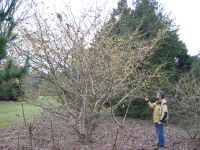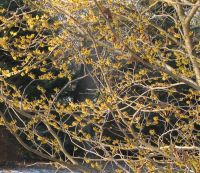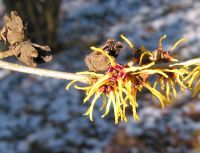Chinese Witch hazel - Hamamelis mollis
English name:
Chinese Witch hazel
Scientific name:
Hamamelis mollis
Family:
Hamamelidaceae (Witch hazel family)
Height:
up to 5 M in Hørsholm
Flowering:
February and March in Denmark
Range:
west and central China
 |
|
 |
 |
The 53 year old Hamamelis mollis in the picture is from seed collected from the oldest tree in the Forest Botanic Garden in Charlottenlund Denmark. It can be found by the first grass plain after one enters the Arboretum, in square 1114 position 2823.
Plant description:
Described as the finest of the Hamamelis species, this remarkable plant is in full bloom by mid-February most years in Hørsholm. While Hamamelis virginiana, (monthly plant in November last year), marks the end of the flowering season in November, this species marks the beginning of the flowering season in February. Thus only two months of the year are without plants if full flower here in the Hørsholm arboretum.
We have 13 examples of Hamamelis mollis in our collection in Hørsholm plus 5 more in our satellite collection in the Forest Botanic Garden in Carlottenlund. Our oldest plant (in Charlottenlund) is from 1907 and looks completely healthy. Individuals in flower fill the air with their delightful perfume, so one often knows when one is getting near even before seeing the flowers. Our plants produce viable seeds. But these often turn out to be hybrids with the Japanese witch hazel, which flowers at the same time. Unfortunately, we have no specimens that are documented to have been collected in the wild.
Hamamelis mollis was scientifically described for the first time in 1888 from specimens collected in and brought to the west in 1879. Our plant from 1907 in the Forest Botanic Haven is probably the first recorded introduction into Denmark and came via the Hesse Nursery, in Ostfriesland, Germany. Perhaps not coincidentally E. H. Wilson collected and re-introduced this species to the west in 1907.
Although not common in gardens, H. mollis deserves to be used much more frequently. It flowers at a time of the year when one is really is missing the sight and smell of flowers. The leaves are an attractive, clear yellow in the autumn. It has few serious disease or insect problems, although we have one poor specimen which is apparently succumbing to the honey fungus (Armillaria sp.).
These deciduous shrubs (or small trees) grow slowly to about 3 to 6 meters high and are as wide as they are high. Leaves are alternate, wider towards the tip than at the middle (obovate), tend to be unequally heart-shaped at the base, and are densely hairy beneath. The species name mollis means soft and perhaps this refers to the soft hairs on the leaves. The leaves turn yellow in the autumn. The 4, golden-yellow, strap-shaped petals are not as crinkled as in H. japonica and are more showy. The calyx at the base of the petals is red-brown in colour. The fruit is a woody capsule that contains two shinny-black seeds.
References:
Bean, W.J. 1976 Trees and Shrubs Hardy in the British Isles Vol II. Pp 318-319 A-C. Bean and Murray publishers.
Houtmen, R. T. & van der Werf, W.J. Hamamelis sortimentsondersoek en keuringsrapport (A report from the assessment of varieties of Hamamelis). Dendroflora 39: 30-59.
Lange, J. 1994. Kulturplanternes Indførelshistorie i Danmark. (Introduction History of Cultivated Plants in Denmark). Jordbrugsforlaget, Frederiksberg C.
Poor, J.M. & Brewster, N.P. 1996. Pp. 128. Plants that Merit Attention. Shrubs. Timber Press Publisher.
Rushforth, K. 1999. Trees of Britain and Europe. Harper Collins Publisher. 1336 Pp.
